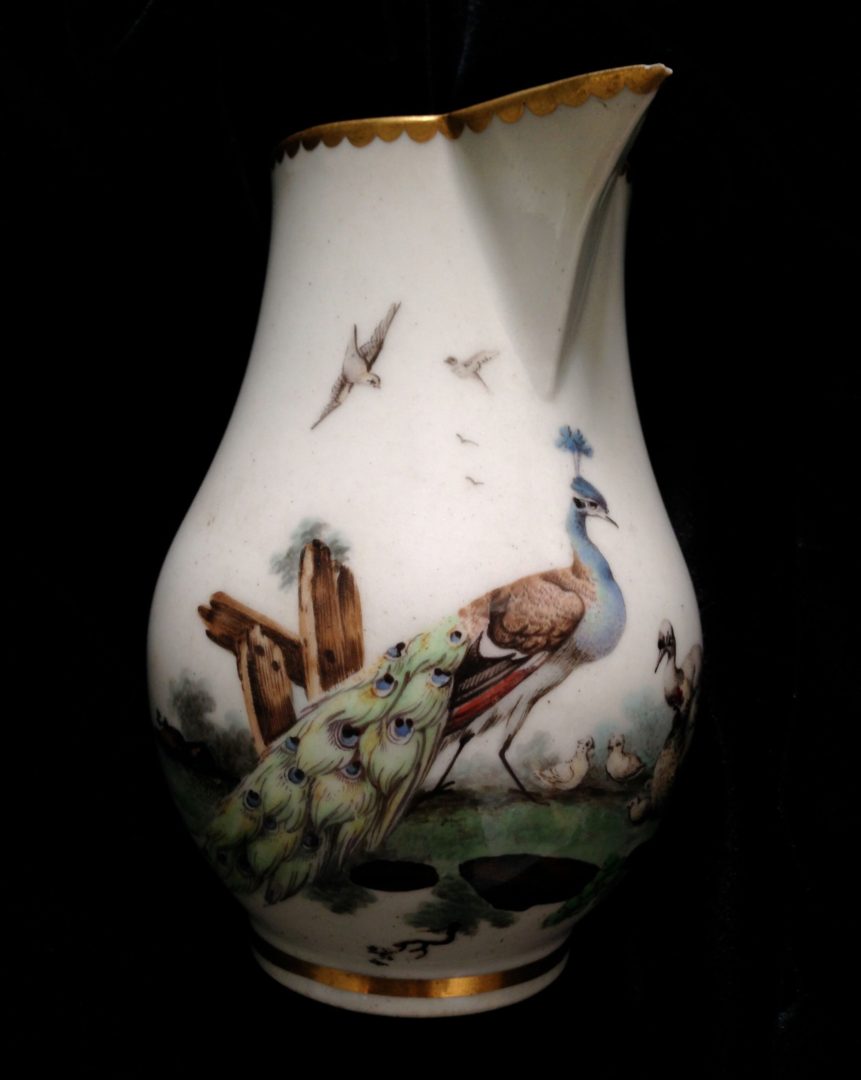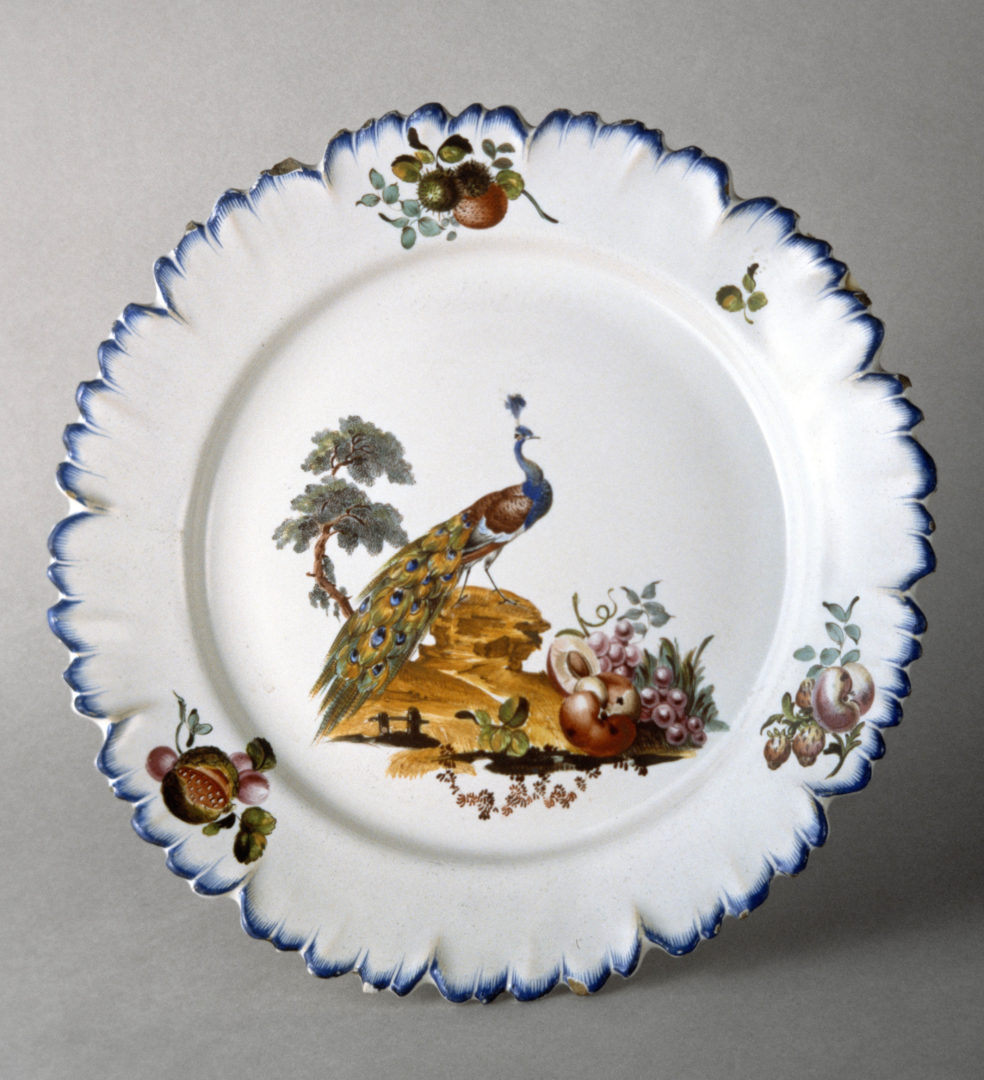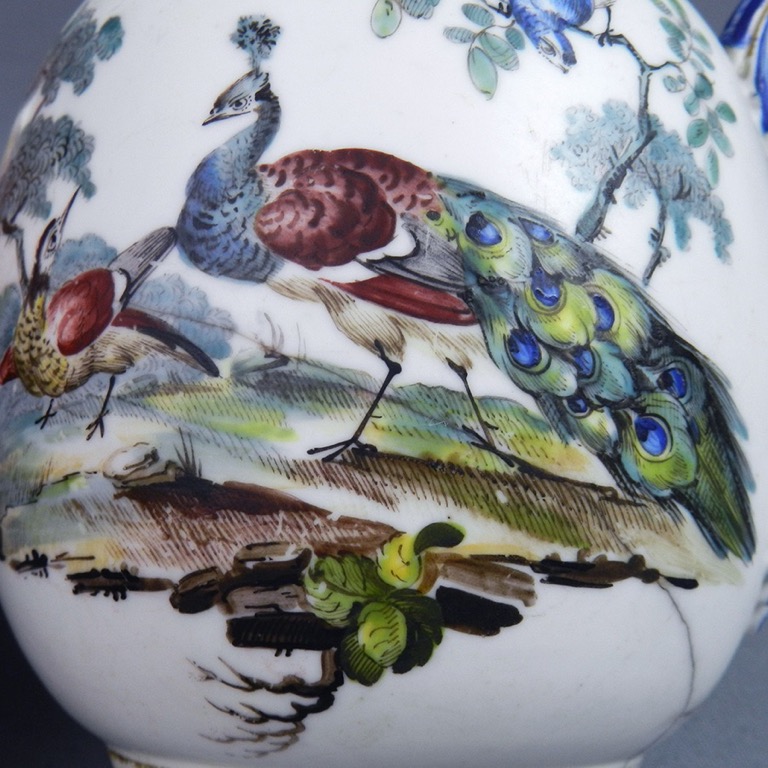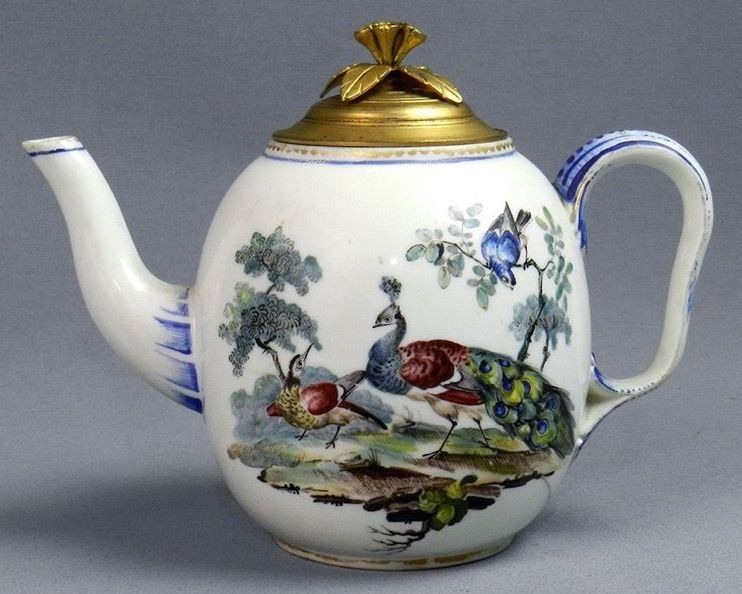2 A Sceaux faience plate, c.1766-68, with bird painting by Duvivier. MNC 21039. Diameter 23.2 cm. Photo: bpk / RMN-Grand-Palais / Sèvres, Cité de la céramique / Martine Beck-Coppola
It is extremely fortunate that an extensive New Hall porcelain service painted with birds by Fidelle Duvivier, and auctioned by Christie’s in London in 1988, has survived intact to the present day in a private English collection. (i) The milk jug of this service (1) is a particularly striking piece with its splendid peacock. (ii) It helped me to identify several other depictions of peafowl on Sceaux faience (2) and Mennecy porcelain (3) as his work, which were also included in my Duvivier book.
The similarities between the New Hall peacock (1) and the one on the Sceaux plate (2) are remarkable when one considers they were painted some twenty years apart. During his first employment at Sceaux (c. 1766-68) Duvivier excelled in bird painting, both on faience and on Mennecy porcelain white wares. The latter were being decorated during that period by Sceaux painters as well as by those Mennecy painters still working at that leased factory. (iii) This fact accounted for the discoveries of Duvivier’s decoration on Mennecy porcelain. Not only do new examples continue to regularly turn up at French auctions, but a splendid Mennecy teapot with a stunning peacock was sold last May by a French Ebay dealer (6 a,b).
The examples shown here (2, 3, 4) have added fruits coupés (cut fruits), which were popular decorative elements used during this period at Sceaux.
4 (Left) A Sceaux faience plate, “1770-1780” (actually 1766-68, with bird decor by Fidelle Duvivier). Musée national Adrien Dubouché, Limoges (inv. ADL73), Diameter 22 cm. Collection Gasnault – Don Adrien Dubouché, 1881. Photo: RMN-Grand Palais (Limoges, Cité de la céramique) / Tony Querrec
All of these examples contain a number of distinctive features by which one can identify Duvivier’s hand. Here is a list of these:
1. There is a noticeably heavy root or branch hanging downward from a pile of rocks and other vegetation (1, 4, 6a).
2. The ground is shaded with fine parallel lines in darker colors (3b, 6a).
3. The bird stands on an elevated rock, or pile of rocks – a characteristic found in Tournai bird painting as well (see blogpost # 9 – August 27, 2017). (2, 3, 4)
4. A tree or bush quite often sticks out diagonally behind the largest bird, as seen on many examples shown in my book, and here in (2, 3, 6). (iv)
5. A small arc of dots often appears under the birds’ eyes, a characteristic I described in blogpost # 7– May 24, 2017 with several examples. (6a)
6. Often the bird’s stance (the position of the legs) is identical on English and French examples (1, 2). Also, a small part of the bird’s legs above the joint is visible amongst the feathers in the thigh (6a), especially on French work.
NOTES
(i) This part-tea service, auctioned by Christie’s, London, on October 10, 1988, lot 237, was acquired by Jonathan Horsfall Turner, who later published many of the pieces in his article, “Some Rare Duvivier Pots,” English Ceramic Circle Transactions, Vol. 20, Part 1 (2008), pp. 139-160. See also my blogpost #6 (March 23, 2017) to learn how a few examples of this service helped identify Duvivier’s birds on two Hague-Tournai plates; and nos. 56 a,b; 58 (full view of the milk jug), 59, 60 on pp. 52-54 of In the Footsteps of Fidelle Duvivier (2016).
(ii) In addition to the “No. 11” mark on the base, most pieces of this service also bore a collector’s label printed with “S. & J. BROWN SLG.” I did some research on this, knowing that “Slg.” is a German abbreviation for Sammlung (collection). While searching the internet for some mention of these persons, I found out that the label referred to Sidney and Jenny Brown of Baden, Switzerland, who were passionate art collectors and mainly known for their exceptional collection of French impressionist art. Sidney William Brown (1865-1941) was the son of Charles Brown, an engineer who lived in Uxbridge near London and later moved the family to Winterthur in Switzerland. He and his brother founded a company that developed electrical engineering projects in Switzerland and abroad. In 1896 Sidney married Jenny Sulzer (1871-1968) of Winterthur and the couple had three sons, the last of whom died in 1987. Since 1990 the Brown villa in Baden, Switzerland has been open to the public as a museum (Stiftung Langmatt) and displays the family’s art collections. It is not known how the Browns came to own this New Hall service, but it was sold at Christie’s in 1988 “under the title of Various Properties, which implies a trade source rather than a private individual or family trust/estate sale.” (I thank Anton Gabszewicz, formerly of Christie’s, for this information).
(iii) See In the Footsteps of Fidelle Duvivier, pp. 18, 19, 22, 41, n. 29.
(iv) See In the Footsteps of Fidelle Duvivier, p. 24, nos. 31a, 32; p. 52, nos. 52c, 56a.








